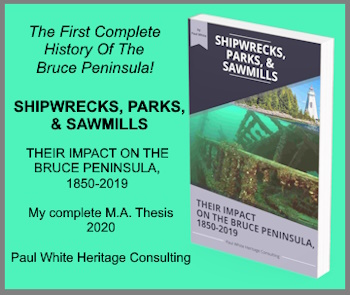Lake Huron Shipwrecks: the Hibou
Lake Huron shipwrecks like the Hibou often occurred in the Georgian Bay region of that Great Lake due to the often violent waters that could strike unsuspecting vessels.
Sitting on my deck at home, I am able to look out over the water of Owen Sound. As a November wind stirred up that water and fog and mist rolled every which-way over Georgian Bay, I thought about what it must be like to sail on that dark grey waterway at this time of year.
As the waves crashed against the shoreline I thought about men like Andrew Port who captained the Prince Alfred along the coast of the Bruce Peninsula carrying vital supplies for the communities of that region.
The brave captain risked his life and his vessel from becoming a Lake Huron shipwreck, sailing until the last possible day each winter and with the first break up of the ice in the spring. Port, and others had their skills tested against everything nature offered in the way of stormy conditions.
Captain Port purchased a new larger vessel, the Jane Miller so he could tackle the late autumn and early spring conditions on Georgian Bay and reduce his chances of becoming a Lake Huron shipwreck. Ironically, he lost his life when the Jane Miller sank in Colpoy's Bay.
The Last of the Lake Huron Shipwrecks
November 2023 marks the 87th anniversary of the last major Lake Huron shipwreck in the Georgian Bay region.
Local residents recalled that the weather had been bad for a few days. But, despite the inclement conditions, on November 21, 1936, the Dominion Transportation Company's vessel, Hibou, left its home port, Owen Sound, on its last voyage of the season. It was carrying 10 tons of cargo and its last port of call was to be Manitowaning on Manitoulin Island.
About one-and-one half miles south of Squaw Point off the east shore of Owen Sound, tragedy struck!
Seven members of the crew, including the Hibou's captain, Norman McKay, a seasoned Great Lakes sailor, lost their lives.
What Caused Lake Huron's Last Shipwreck?
Speculation ran rampant in the port of Owen Sound as to what had caused Lake Huron's last major shipwreck. One survivor, Ross Galbraith, told a local reporter that "she took a bad list to starboard" and then went over. To support this statement, rumours went around Owen Sound that there were cattle on board and that perhaps they had not been properly quartered. The story continued. It was possible that if the cattle had moved en masse, the ship could not adjust itself in the heavy swell.
It is remarkable that ten of the seventeen crew members survived. After all, Georgian Bay at that time of year was icy cold and the weather conditions had been less than comfortable. One survivor, suffering from exposure after being in the water for two hours, joked that "this is not the time of year to go swimming.
All of the survivors remembered Captain McKay standing on the deck lighting flares in order to attract rescuers, and probably to light the way for his crew to find their way to the safety of the shore.
While the flares notified those who happened to be near the water at his hour of the day, the ship also sounded distress signals, which were heard throughout the area. In fact, one man, who was a youngster at the time, recalled his father telling them at their Sarawak home, that he had heard the signal that a ship was in trouble. Later that day, the whole community knew about the tragic fate of the Hibou.
In a community that historically depended upon water transportation for a larger part of its economic stability, the possibility of a shipping disaster was a part of life. Fortunately, the last 80 years have been relatively kind to the mariners of the the Grey and Bruce region as their have not been any more Lake Huron shipwrecks.
A version of this article appeared in my Local History column in the Owen Sound Sun Times in November 1996.
Georgian Bay Shipping
List of Lighthouses on the Great Lakes: If you have names and/or pictures of Great Lakes Lighthouses please submit them along with details of their location.
Georgian Bay Ships: A List of all the ships that sailed on Georgian Bay until the 1960s. This list is not complete. If you know of a ship that sailed the waters of Georgian Bay please contact me with information about that vessel, and, if you have a picture that I could post with it, that would be much appreciated.
1885: A Memorable Summer Job for Owen Sound teenage boys on the Great Lakes would have historic importance, not mention a possible exciting career opportunity.
Hindman Transportation Company was a well-known Great Lakes shipping company for many years. Here you will find pictures of many of the Hindman ships
Owen Sound Harbour – A Photographic History, by Robert A. Cotton is a book that interests my historiographical curiosity.
Commercial Great Lakes Fishing It is probably safe to suggest that the commercial fishing industry was an important part of the early growth of this region.
A Georgian Bay fishing vacation has long been a popular attraction in the Bruce Peninsula region. During fishing derbies, the regional waterways are dotted with fishing boats of all shapes and sizes.
The Georgian Bay Mackinaw, designed by William Watts of Collingwood is an example of a Georgian Bay innovator creating a vessel to service the needs local mariners.
Great Lakes fishing is an asset that is protected and developed, not only for its economic potential but also for those who just enjoy spending a day by the side of a river or in small fishing boats trying to catch “the big one”!
Great Lakes Fishing History is not without its controversy. The impact of the fishing industry was such that it played an important role in the development of communities along the Georgian Bay and Lake Huron shoreline.
Georgian Bay Travel Before the Winter Freeze-Up could be a dangerous time for mariners in the early years in this region.
A Harbinger of Spring on the Great Lakes in pioneer times, was the eagerly awaited news that a lighthouse had been lit and shipping traffic could begin sailing from port to port.
Lumber Hookers Lumber hookers and tugs were an important innovation to improve the transportation of lumber on Georgian Bay.
Mapmakers on Georgian Bay were also explorers. They mapped the Georgina Bay shoreline noting safe harbours, dangerous reefs and other guides for sailors and pioneer settlers looking for a place to call home.
Paddling Georgian Bay & Pondering: traversing parts of this great waterway in a canoe leads one to wonder about the ships of a bygone era battling the rough seas they encountered.
Parry Sound Shipping History: The Parry Sound area has always been connected to the southern regions of the Province of Ontario by a system of good roads. Or has it?
Parry Sound’s shipping history 2 is more than the tragic sinking of the Waubuno or the later catastrophe surrounding the sinking of the Asia.
Sailing Season Closing: A Frantic Time on Peninsula as ships raced from port to port delivering and picking up passengers and produce before the waterways froze.
Ship Captain Andrew Port was not only a dynamic and brave Georgian Bay mariner, he was a personal favourite historical character of mine.
Ships Stuck in Ice: The Oak Glen was icebound in 1996 but this sailing hazard has been impacting vessels on Georgian Bay since the beginning of time.
Lake Huron shipwrecks, the Hibou often occurred in the Georgian Bay region of that Great Lake due to the often violent waters that could strike unsuspecting vessels like the Hibou.
Shipwrecks: The "Asia" wrecked off the eastern coast of Georgian Bay taking all but two of the more than 100 passengers to a watery grave.
Masters, Mates, and Pilots Association created its first Canadian chapter on Georgian Bay, providing maritime safety education, and other seafaring issues to better inform its membership.
Pioneer Travel Aboard the Fly Tells the story of a sailing vessel as the tenuous link between survival and death in a pioneer settlement in the 1840's in Upper Canada.
Sailing Stories: the Captain Who Smelled his way into Port The Captain Who Smelled his Way into Port details how pioneer seamen on Georgian Bay safely sailed the rough waters without the aid of the modern technological tools so readily used by today's mariners.
Sailing Story: The Voyage of the Prince Alfred the incredible voyage of the Prince Alfred, fraught with danger for both vessel and the crew in the winter of 1880.
Shipbuilding As the southern Georgian Bay region became more populated shipping traffic increased to meet the needs of an expanding market place.
The Summer of 1844 was No Picnic for the early settlers in the pioneer area near what would become Owen Sound on Georgian Bay.
The CPR Grain Elevator Fire of 1911 spelled the end of Owen Sound's role as the eastern terminus of the CPR Great Lakes Fleet.
Georgian Bay shipping occurred long before the first Europeans paddled these waters. But the fur and timber trades opened Georgian Bay to shipping in a big way!





